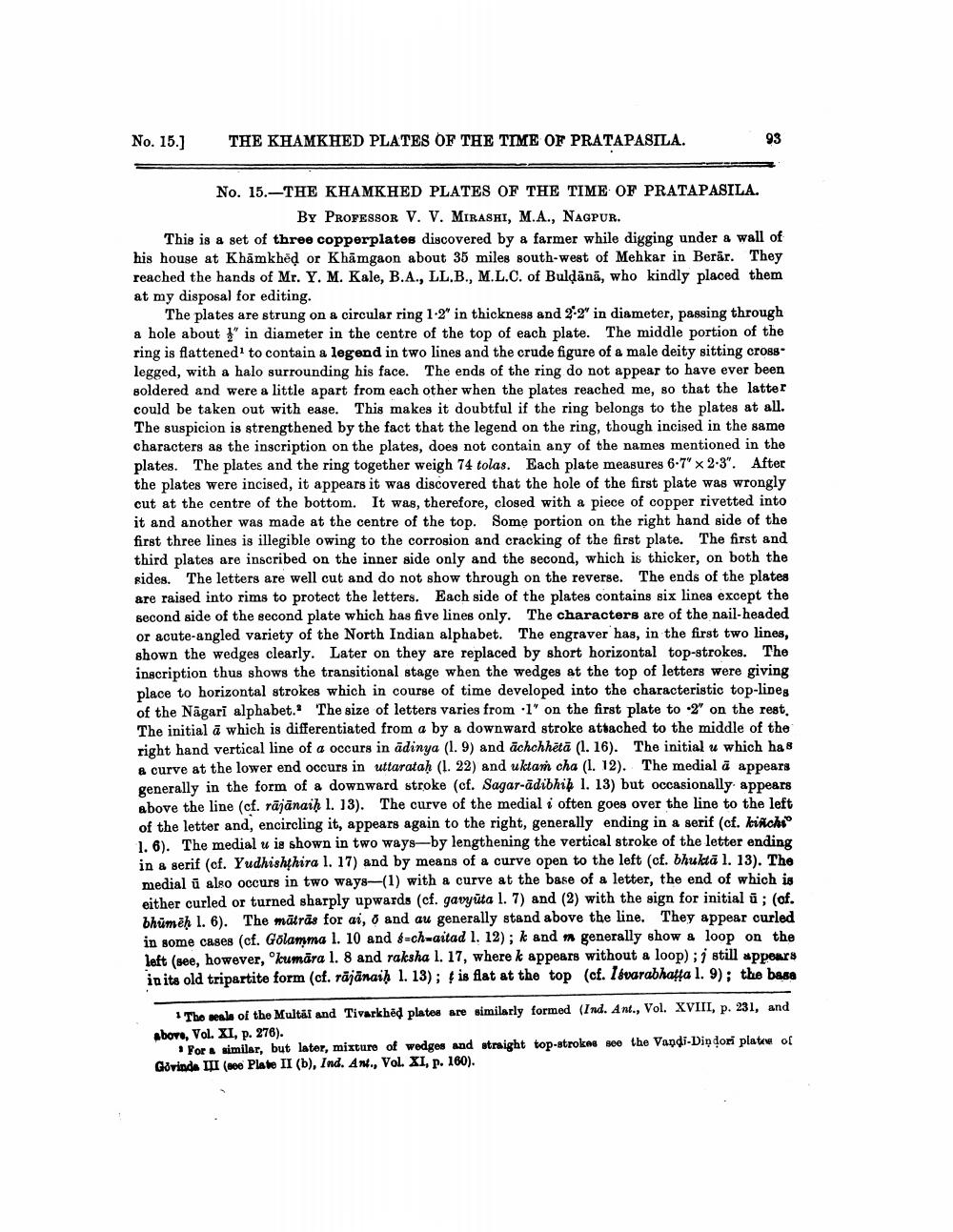________________
No. 15.]
THE KHAMKHED PLATES OF THE TIME OF PRATAPASILA.
93
No. 15.—THE KHAMKHED PLATES OF THE TIME OF PRATAPASILA.
By PROFESSOR V. V. MIRASHI, M.A., NAGPUR. This is a set of three copperplates discovered by a farmer while digging under a wall of his house at Khāmkhed or Khamgaon about 35 miles south-west of Mehkar in Berär. They reached the hands of Mr. Y. M. Kale, B.A., LL.B., M.L.C. of Buldānā, who kindly placed them at my disposal for editing.
The plates are strung on a circular ring 1.2" in thickness and 2.2" in diameter, passing through a hole about 1' in diameter in the centre of the top of each plate. The middle portion of the ring is flattened to contain a legend in two lines and the crude figure of a male deity sitting crosslegged, with a halo surrounding his face. The ends of the ring do not appear to have ever been soldered and were a little apart from each other when the plates reached me, so that the latter could be taken out with ease. This makes it doubtful if the ring belongs to the plates at all. The suspicion is strengthened by the fact that the legend on the ring, though incised in the same characters as the inscription on the plates, does not contain any of the names mentioned in the plates. The plates and the ring together weigh 74 tolas. Each plate measures 6.7" x 2.3". After the plates were incised, it appears it was discovered that the hole of the first plate was wrongly cut at the centre of the bottom. It was, therefore, closed with a piece of copper rivetted into it and another was made at the centre of the top. Some portion on the right hand side of the first three lines is illegible owing to the corrosion and cracking of the first plate. The first and third plates are inscribed on the inner side only and the second, which is thicker, on both the sides. The letters are well cut and do not show through on the reverse. The ends of the plates are raised into rims to protect the letters. Each side of the plates contains six lines except the second side of the second plate which has five lines only. The characters are of the nail-headed or acute-angled variety of the North Indian alphabet. The engraver has, in the first two lines, shown the wedges clearly. Later on they are replaced by short horizontal top-strokes. The inscription thus shows the transitional stage when the wedges at the top of letters were giving place to horizontal strokes which in course of time developed into the characteristic top-lipeg of the Nāgari alphabet. The size of letters varies from 1' on the first plate to .2" on the rest. The initial ā which is differentiated from a by a downward stroke attached to the middle of the right hand vertical line of a occurs in adinya (1.9) and achchhëtä (1. 16). The initial u which ha 8 & curve at the lower end occurs in uttaratah (1. 22) and uktam cha (1. 12). The medial a appears generally in the form of a downward stroke (cf. Sagar-ādibhiḥ 1. 13) but occasionally appears above the line (cf. rājānaiḥ 1. 13). The curve of the medial i often goes over the line to the left of the letter and, encircling it, appears again to the right, generally ending in a serif (cf. kinchs 1. 6). The medial u is shown in two ways-by lengthening the vertical stroke of the letter ending in a serif (cf. Yudhishthira 1. 17) and by means of a curve open to the left (cf. bhuktā l. 13). The medial ū also occurs in two ways—(1) with a curve at the base of a letter, the end of which is either curled or turned sharply upwards (cf. gavyūta 1. 7) and (2) with the sign for initial û ; (of. bhūmēh 1. 6). The mātrās for ai, o and au generally stand above the line. They appear curled in some cases (cf. Golamma 1. 10 and 8-ch-aitad 1. 12); k and a generally show & loop on the left (see, however, "kumāra 1. 8 and raksha l. 17, where k appears without a loop); 7 still appears in its old tripartite form (cf. rājānaiḥ 1. 13); 4 is flat at the top (cf. Isvarabhata l. 9); the basa
Tho seals of the Multai and Tivarkhēd plates are similarly formed (Ind. Ant., Vol. XVIII, p. 231, and above, Vol. XI, p. 276).
For similar, but later, mixture of wedges and straight top-strokes see the Vandi-Dindori plate of Govinda II (se Plate II (b), Ind. Ant., Vol. XI, p. 160).




